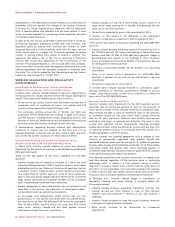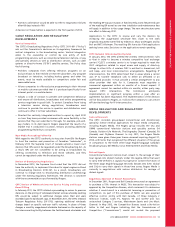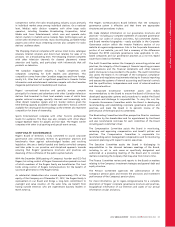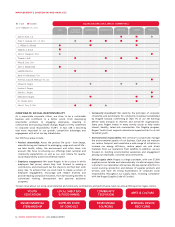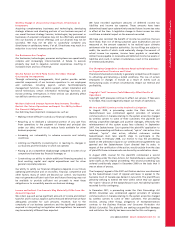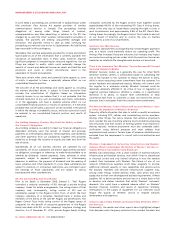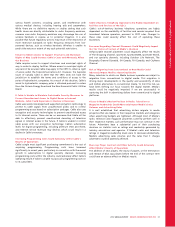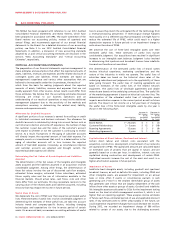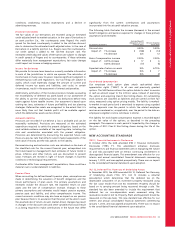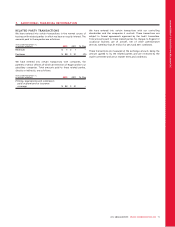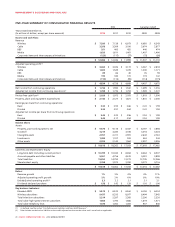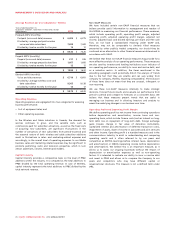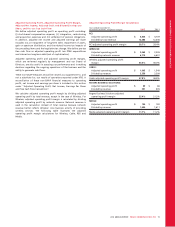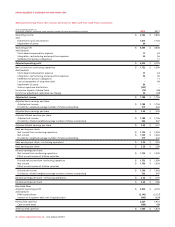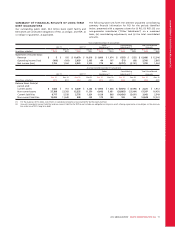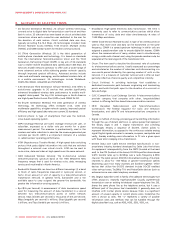Rogers 2012 Annual Report Download - page 72
Download and view the complete annual report
Please find page 72 of the 2012 Rogers annual report below. You can navigate through the pages in the report by either clicking on the pages listed below, or by using the keyword search tool below to find specific information within the annual report.
MANAGEMENT’S DISCUSSION AND ANALYSIS
6. ACCOUNTING POLICIES
This MD&A has been prepared with reference to our 2012 Audited
Consolidated Financial Statements and Notes thereto, which have
been prepared in accordance with IFRS. The Audit Committee of the
Board reviews our accounting policies, reviews all quarterly and
annual filings, and recommends approval of our annual financial
statements to the Board. For a detailed discussion of our accounting
policies, see Note 2 to our 2012 Audited Consolidated Financial
Statements. In addition, a discussion of new accounting standards
adopted by us and critical accounting estimates are discussed in the
sections “New Accounting Standards” and “Critical Accounting
Estimates”, respectively.
CRITICAL ACCOUNTING ESTIMATES
The preparation of our financial statements requires management to
make estimates and assumptions that affect the reported amounts of
assets, liabilities, revenues and expenses and the related disclosure of
contingent assets and liabilities. These estimates are based on
management’s experience and various other assumptions that are
believed to be reasonable under the circumstances, the results of
which form the basis for making judgments about the reported
amounts of assets, liabilities, revenue and expenses that are not
readily apparent from other sources. Actual results could differ from
those estimates. We believe that the accounting estimates discussed
following are critical to our business operations and an
understanding of our results of operations or may involve additional
management judgment due to the sensitivity of the methods and
assumptions necessary in determining the related asset, liability,
revenue and expense amounts.
Allowance for Doubtful Accounts
A significant portion of our revenue is earned from selling on credit
to individual consumers and business customers. The allowance for
doubtful accounts is calculated by taking into account factors such as
our historical collection and write-off experience, the number of days
the customer is past due and the status of the customer’s account
with respect to whether or not the customer is continuing to receive
service. As a result, fluctuations in the aging of subscriber accounts
will directly impact the reported amount of bad debt expense. For
example, events or circumstances that result in a deterioration in the
aging of subscriber accounts will in turn increase the reported
amount of bad debt expense. Conversely, as circumstances improve
and customer accounts are adjusted and brought current, the
reported bad debt expense will decline.
Determining the Fair Values of Assets Acquired and Liabilities
Assumed
The determination of the fair values of the tangible and intangible
assets acquired and the liabilities assumed in an acquisition involves
considerable judgment. Among other things, the determination of
these fair values involves the use of discounted cash flow analyses,
estimated future margins, estimated future subscribers, estimated
future royalty rates and the use of information available in the
financial markets. Should actual rates, cash flows, costs and other
items differ from our estimates, this may necessitate revisions to the
carrying value of the related assets and liabilities acquired, including
revisions that may impact net income in future periods.
Useful Lives of Assets
We depreciate the cost of PP&E over their respective estimated useful
lives. These estimates of useful lives involve considerable judgment. In
determining the estimates of these useful lives, we take into account
industry trends and company-specific factors, including changing
technologies and expectations for the in-service period of certain
assets. On an annual basis, we reassess our existing estimates of useful
lives to ensure they match the anticipated life of the technology from
a revenue-producing perspective. If technological change happens
more quickly or in a different way than anticipated, we might have to
reduce the estimated life of PP&E, which could result in a higher
depreciation expense in future periods or an impairment charge to
write down the value of PP&E.
We amortize the cost of finite-lived intangible assets over their
estimated useful lives. These estimates of useful lives involve
considerable judgment. Our acquisitions have resulted in significant
increases to our intangible asset balances. Judgment is also involved
in determining that spectrum and broadcast licences have indefinite
lives and are therefore not amortized.
The determination of the estimated useful lives of brand names
involves historical experience, marketing considerations and the
nature of the industries in which we operate. The useful lives of
subscriber bases are based on the historical churn rates of the
underlying subscribers and judgments as to the applicability of these
rates going forward. The useful lives of roaming agreements are
based on estimates of the useful lives of the related network
equipment. The useful lives of wholesale agreements and dealer
networks are based on the underlying contractual lives. The useful life
of the marketing agreement is based on historical customer lives. The
determination of the estimated useful lives of intangible assets
impacts amortization expense in the current period as well as future
periods. The impact on net income on a full year basis of changing
the useful lives of the finite-lived intangible assets by one year is
shown in the following chart.
(In millions of dollars) Amortization
Period
Increase in
Net Income
if Life
Increased
by 1 year
Decrease in
Net Income
if Life
Decreased
by 1 year
Brand Names 7 – 20 years $ 1 $ (1)
Customer Relationships 3 – 5 years $ 12 $ (19)
Roaming Agreements 12 years $ 3 $ (4)
Marketing Agreements 3 years $ 1 $ (2)
Capitalization of Direct Labour, Overhead and Interest
Certain direct labour and indirect costs associated with the
acquisition, construction, development or betterment of our networks
are capitalized to PP&E. The capitalized amounts are calculated based
on estimated costs of projects that are capital in nature, and are
generally based on a rate per hour. In addition, interest costs are
capitalized during construction and development of certain PP&E.
Capitalized amounts increase the cost of the asset and result in a
higher amortization expense in future periods.
Impairment of Assets
Indefinite-lived intangible assets, including goodwill and spectrum/
broadcast licences, as well as definite life assets, including PP&E and
other intangible assets, are assessed for impairment on an annual
basis or more often if events or circumstances warrant. A cash
generating unit (“CGU”) is the smallest identifiable group of assets
that generates cash inflows that are largely independent of the cash
inflows from other assets or groups of assets. Goodwill and indefinite
life intangible assets are allocated to CGUs for the impairment testing
based on the level at which management monitors it, which is not
higher than an operating segment. These analyses involve estimates
of future cash flows, estimated periods of use and applicable discount
rates. If key estimates were to differ unfavourably in the future, we
could experience impairment charges that could decrease net income.
During 2012, we recorded an impairment charge of $80 million
related to certain of our assets, due to the challenging economic
68 ROGERS COMMUNICATIONS INC. 2012 ANNUAL REPORT


